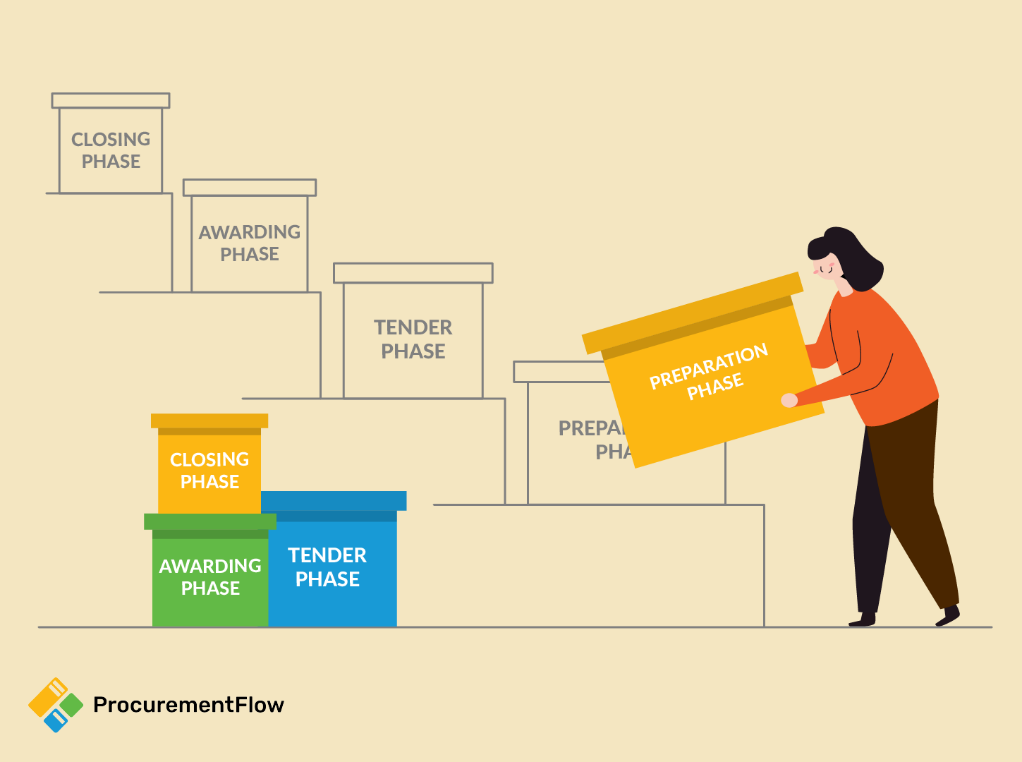Login
Login
Register
Complete Your Profile
Change Password
Request a Password Reset
Download Documents
Download Documents
Get Help to Participate in This Tender
Change Password
For better security, update the account password.
Home » RFQ: Secrets of Writing a Winning Request for Quotation
RFQs are commonly used in the procurement process when a company needs to purchase products or services and wants to compare offers from different suppliers. This article will help you to understand the specific details of what is an RFQ, the nuances of writing a good RFQ, the RFQ process, and how to respond to an RFQ.
Understanding RFQ Definition, its Contents and Importance
A Request For Quote (RFQ), also known as an invitation for bid (IFB), is a process in which a purchasing company through a formal document solicits select suppliers and contractors to submit price quotations and bids and thus provides opportunities to suppliers to fulfill certain specific tasks or projects.
RFQs are most beneficial to businesses that require a constant and consistent supply of products and services with set specifications and standards. The suppliers or service providers that are better organized usually have higher chances of creating a streamlined RFQ that offers the best match to the requirements of an enterprise, every time.
For example, an enterprise that wants to buy 500 HP Laptops with specific hard drive sizes and processing speeds, screen sizes, etc., would send an RFQ to several vendors as prospective bidders. The enterprise, after receiving the price quotations, can choose the vendor that best matches its criteria for the goods or services.
RFQs may include details such as pricing, payment terms, factors that could influence a company's bid selection, submission deadline, delivery parameters, etc.
RFQs are not public announcements. Because the soliciting company sends RFQs only to businesses that it trusts, it does not need to prepare lengthy procurement documentation. Since this is not sent publicly, a company gets bids only from the suppliers it had sent the RFQ, which helps save time.
RFQs help in streamlining the procurement process, bringing in transparency, and facilitating fair competition among potential suppliers. They also help in securing the best value for the company while maintaining quality standards and meeting project timelines.
Are there different types of RFQs?
A Request For Quotation (RFQ) can be formulated in different ways, as outlined below:
Open bid
An open bid is a request for quote format in which the buyer publicly opens the bid during submission time.
The pricing and payment terms of suppliers are available for everyone to view. Open bids encourage a competitive process but may prompt vendors to fix higher prices.
Sealed bid
In a sealed bid process, all qualified bidders send their bids. These bids are opened after receiving all responses.
Sealed bids are considered a more transparent bidding format compared to open bids. Government or public sector contracts commonly use sealed bids in their procurement process.
Invited bid
An invited bid is a request for a quote where selected vendors are invited to send in their bids. Invited bids are cost-effective as only trusted or pre-vetted suppliers are chosen to participate.
However, while the supplier selection process seems easier to navigate, buyers may miss out on cost savings due to the limited competition.
Reverse auction
A reverse auction is a request for quotation method in which vendors give their best (lowest) offers for the buyer’s consideration.
Many companies conduct reverse auctions when they fail to find vendors. Reverse auctions can be a good option if cost is the primary criterion for awarding a contract. Conducting reverse auctions online can give quick results besides being competitive for companies.
RFQ process
The RFQ process has the following 4 phases

Step 1- Preparation phase
Need identification: As a first step, the procuring organization identifies its specific needs and requirements for the goods or services they wish to purchase, including quantity and quality standards.
RFQ Creation: The procurement team creates a formal detailed RFQ document based on the identified requirements. The document includes details about the products or services intended to be purchased, the scope of work, quantities, quality specifications, delivery schedules, payment terms, evaluation criteria, and any other relevant terms and conditions.
Issuing the RFQ: The formal detailed RFQ document, when ready, is sent ONLY to potential suppliers or vendors who are known to provide the required products or services through various means, such as email, online procurement portals, or by physically mailing the document.
Step 2- Processing phase
Responses review: Suppliers review the RFQ and provide their quotations, with details of the price, delivery terms, product/service specifications, and other relevant information as requested. Suppliers may also seek clarification from the RFQ issuing company if any aspect of the RFQ is unclear.
Evaluation of Quotations: After the submission deadline is over, the organization's procurement team evaluates the received quotations based on various factors such as price, quality, delivery time, vendor reputation, and any other relevant considerations and rank or score the suppliers.
Step 3- Awarding phase
Selection of Supplier: The organisation’s procurement team uses its evaluation parameters and selects the most suitable supplier that meets its requirements and based on lowest price, best value for money, or a combination of factors as per the score/rank.
Step 4- Closing phase
Negotiation: The organisation may in some cases also negotiate with the chosen supplier to finalize the terms of the agreement.
Purchase Order: The organisation issues the final Purchase order to the selected supplier and formalizes the purchase agreement. The Purchase Order could be a ready format that could include the price, delivery schedule and location, and terms of payment.
Order Fulfilment: The supplier delivers the product/service as per the Purchase order and the company receives the goods or services.
How to write an effective Request for Quotation (RFQ)

An effective detailed Request for Quotation (RFQ) document is of vital importance to the suppliers or vendors. Hence it is very important to clearly mention the organisation’s purchase parameters in order to receive accurate and competitive quotations from potential suppliers or vendors.
The following steps will help the procurement company write an effective RFQ.
1. Listing the specific requirements: Before writing the RFQ, make a list of all that is desired with respect to the product/service. Clearly define the goods or services you require, the quantities, quality standards, delivery schedule, technical specifications, dimensions, weight, certifications, and any other relevant details. This will help receive relevant and accurate quotations from suppliers.
2. Define evaluation parameters: The procurement team must form its best evaluation parameters to justifiably evaluate the supplier quotation. The parameters may include price, quality, experience, delivery time, financial stability, past performance, client references, and other relevant factors. Each of the parameters could be assigned weights or rankings as per the purchase requirements and the score for each supplier can be obtained.
3. Define the format of submission by supplier: The procurement team must clearly outline the format in which suppliers should submit their quotations (e.g., unit price, total price, taxes, discounts, client testimonials, etc.).
4. Provide Samples, Supporting Documents: The procurement team can also provide relevant supporting documents such as technical drawings, designs, product specifications, and samples. This will help the suppliers to better understand your requirements and prepare accurate quotations.
5. Provide Submission Details: The RFQ must have a reasonable deadline for suppliers to submit their quotations with clear instructions on how and where suppliers should submit their proposals, including contact information.
6. Review of Past RFQs: The procurement team can review its previously issued RFQs and can incorporate in the RFQ the aspects which help to avoid potential pitfalls and optimize the current RFQ.
7. Seek Legal Input (if needed): Consider seeking legal counsel to ensure that your RFQ is legally sound and protects the interests of your organization.
8. Involve Stakeholders: Involve the relevant stakeholders, such as the end-users or the project team, in the process of creating the RFQ. Their input can help build a perfect RFQ that aligns with the overall procurement objectives.
9. Be Responsive to Supplier Queries: Be open to clarify any doubts or questions raised by potential suppliers during the RFQ process. This will help to develop credibility leading to a positive and collaborative relationship with suppliers.
The above steps help in creating a well-defined, structured, and effective RFQ, helping attract competitive quotations and facilitate a smooth procurement process. This also helps in forging credibility, leading to a positive and collaborative relationship with suppliers.
Conclusion
Request For Quotation (RFQ) is an important tool the procurement teams use for consistent and specific purchases. A Request For Quotation (RFQ) procedure can require a great deal of communication and collaboration between contractors and vendors, which can be a time-consuming operation. The prevalence of E-RFQ through the use of technology and software helps vastly improve the procurement process and is gaining importance. It can help procurement teams to keep track of their quotes, access supplier information and past quotations, and facilitate easier communication with vendors. Because of this, they can achieve better outcomes compared to more traditional methods.
.jpg)